-
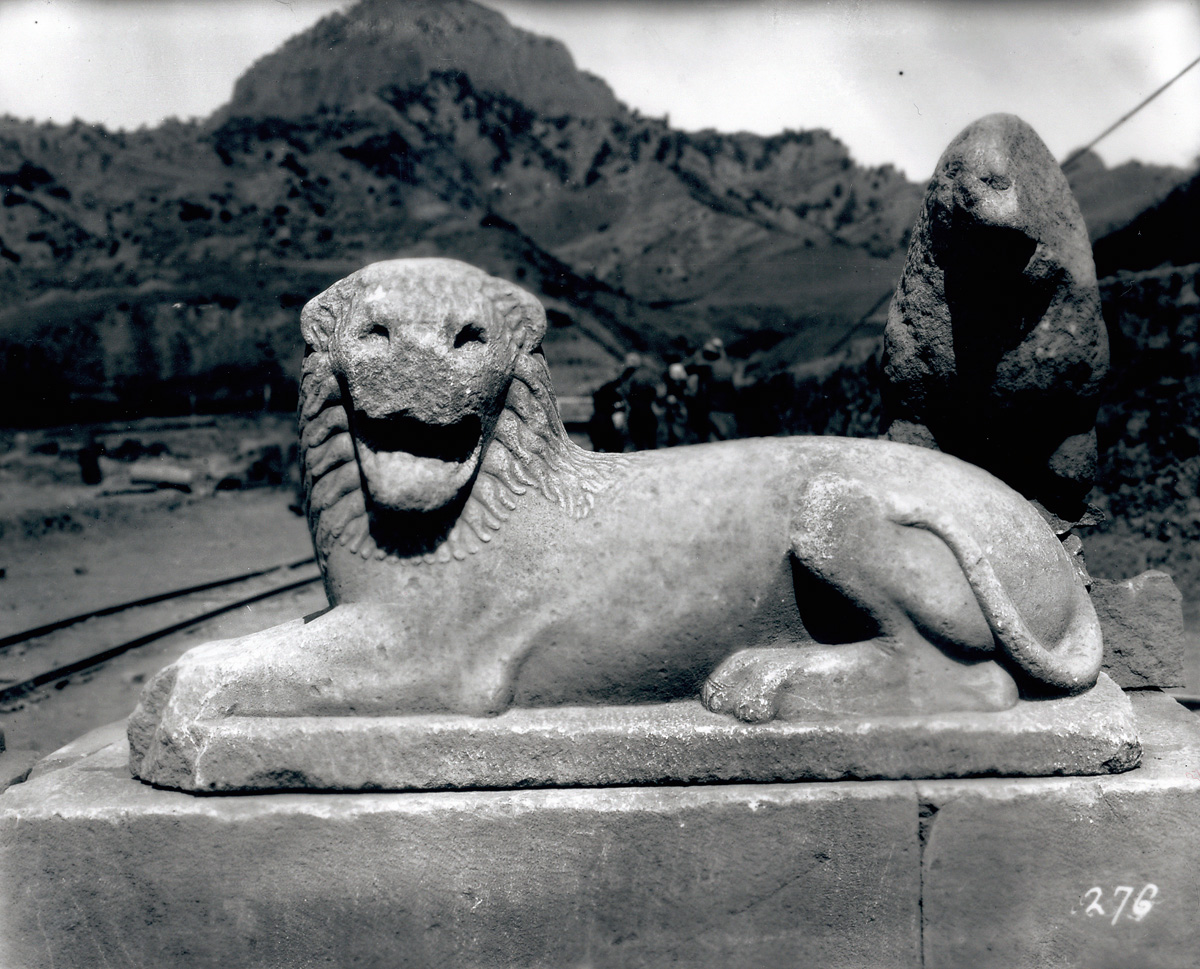 Recumbent Lion From Nannas Monument
Recumbent Lion From Nannas MonumentR2 Cat. 236
Sculpture
Marble, Stone
550-540 BC (Lydian or Late Lydian)
On a plinth with forepaws extended in front, the lion has its head turned to the l. with the mouth wide open and tongue protruding. The eyes are hollow for inlay, the ears fairly close to the head. The mane is arranged in leaf-like locks, many ending...
-
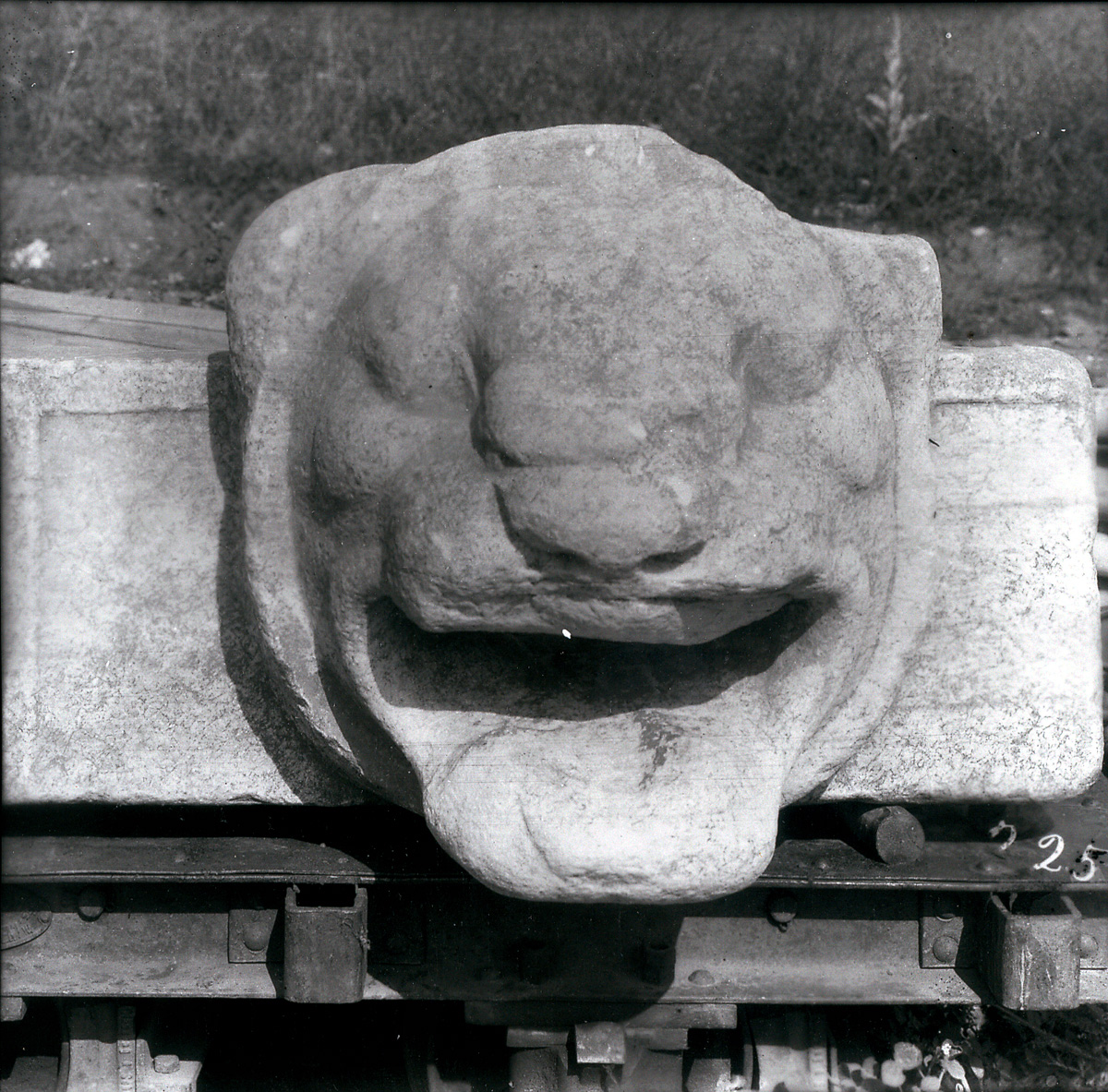 Lion Spout Attached to Rectangular Member
Lion Spout Attached to Rectangular MemberR2 Cat. 237
Sculpture
Marble, Stone
(Lydian?)
"This [colossal lion's head] in all probability belonged to the cornice of the temple and when in place, stood in a position almost directly above the spot where it was found, being the water-spout nearest the corner of the temple. The scale of the h...
-
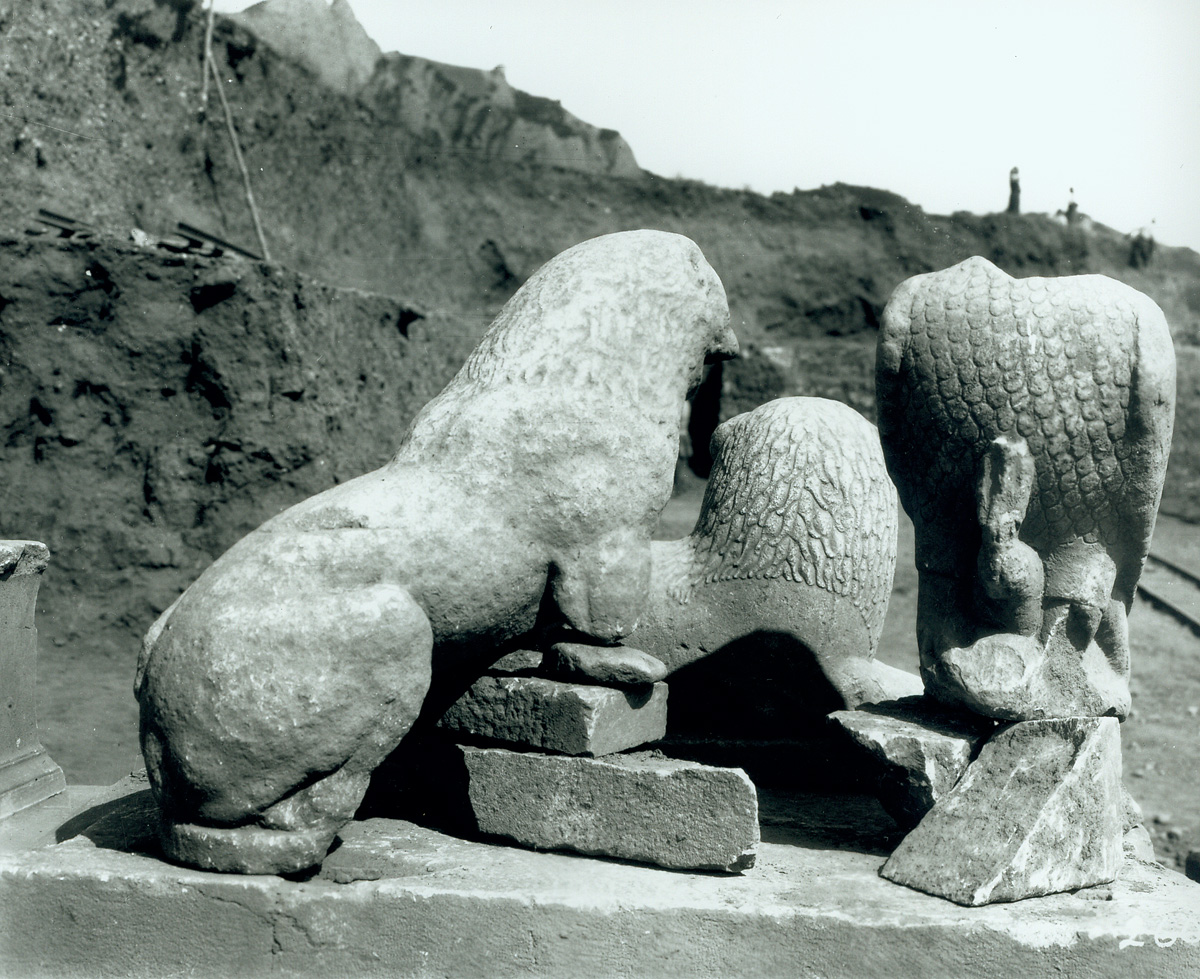 Bird of Prey (Eagle?) Holding a Hare, from the Nannas monument
Bird of Prey (Eagle?) Holding a Hare, from the Nannas monumentR2 Cat. 238
Sculpture
Marble, Stone
Late archaic? (Lydian?)
A sitting bird of prey is holding with slightly bent talons a long-eared creature -- hare or rabbit. The wings are folded on the back; they have three tiers of long feathers, while the front part is stylized in small vertical ovals. The chest feather...
-
 Sphinx, presumably part of a throne or seat
Sphinx, presumably part of a throne or seatR2 Cat. 239
Sculpture
Marble, Stone
480-450 BC (Late Lydian (Persian))
The seated sphinx is partly in the round, partly in relief. A rectangular slab has been worked so that the forelegs and frontal lower part of the body stand free. Behind the head (now lost) and upper part of the body the background was retained and w...
-
 Part of Sepulchral Stele with Palmette
Part of Sepulchral Stele with PalmetteR2 Cat. 240
Sculpture
Marble, Stone
Ca. 420-400 BC (Late Lydian (Persian))
The stele has an oval finial, seven-petalled palmette on antithetic horizontal spirals, and downward-pointed small lotus. The anthemion projects slightly to the spectator's r. "The lateral projection ... was probably next to the dromos, whereas the s...
-
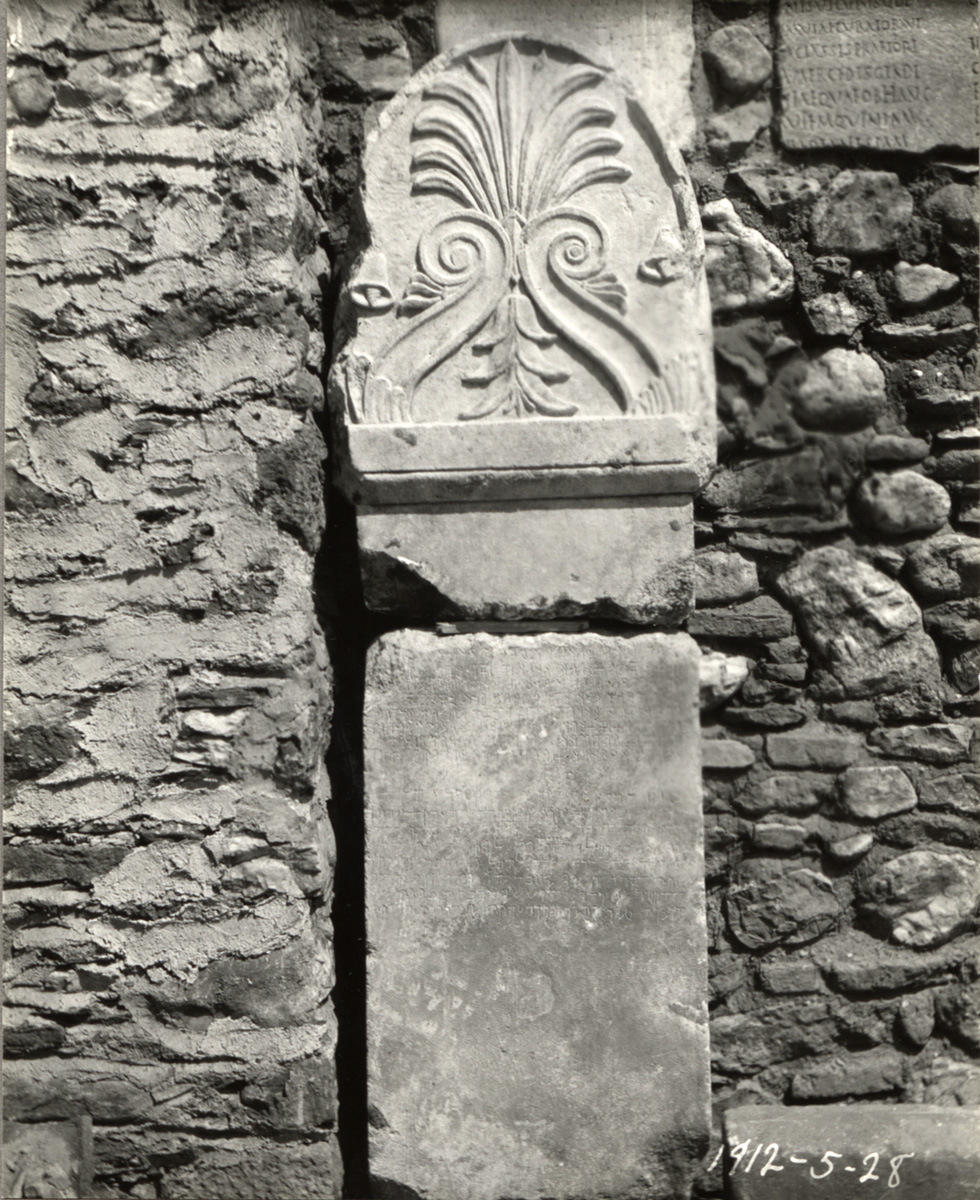 Anthemion with Lydian-Aramaic Bilingual Inscription, Stele of Manes, Son of Kumlis
Anthemion with Lydian-Aramaic Bilingual Inscription, Stele of Manes, Son of KumlisR2 Cat. 241
Sculpture
Marble, Stone
394 BC (Late Lydian (Persian))
Two vertical half-volutes grow out of small acanthus chalices to support a seven-leaf simple palmette. Two small flowers (or ears of corn?) flank the central petal. Three large downward-pointed chalices are in the center below the palmette. Below the...
-
 Stele of Alikres, Son of Karos
Stele of Alikres, Son of KarosR2 Cat. 242
Sculpture
Marble, Stone
Early 4th C. BC (Late Lydian (Persian))
Funerary stele with Lydian inscription and rounded palmette anthemion, stele of Alikres, son of Karos.
Grayish "local" marble. Much reddish incrustation on face. Piece of marble broken off at top. According to Buckler (Sardis VI, 2, 49) bottom is origi...
-
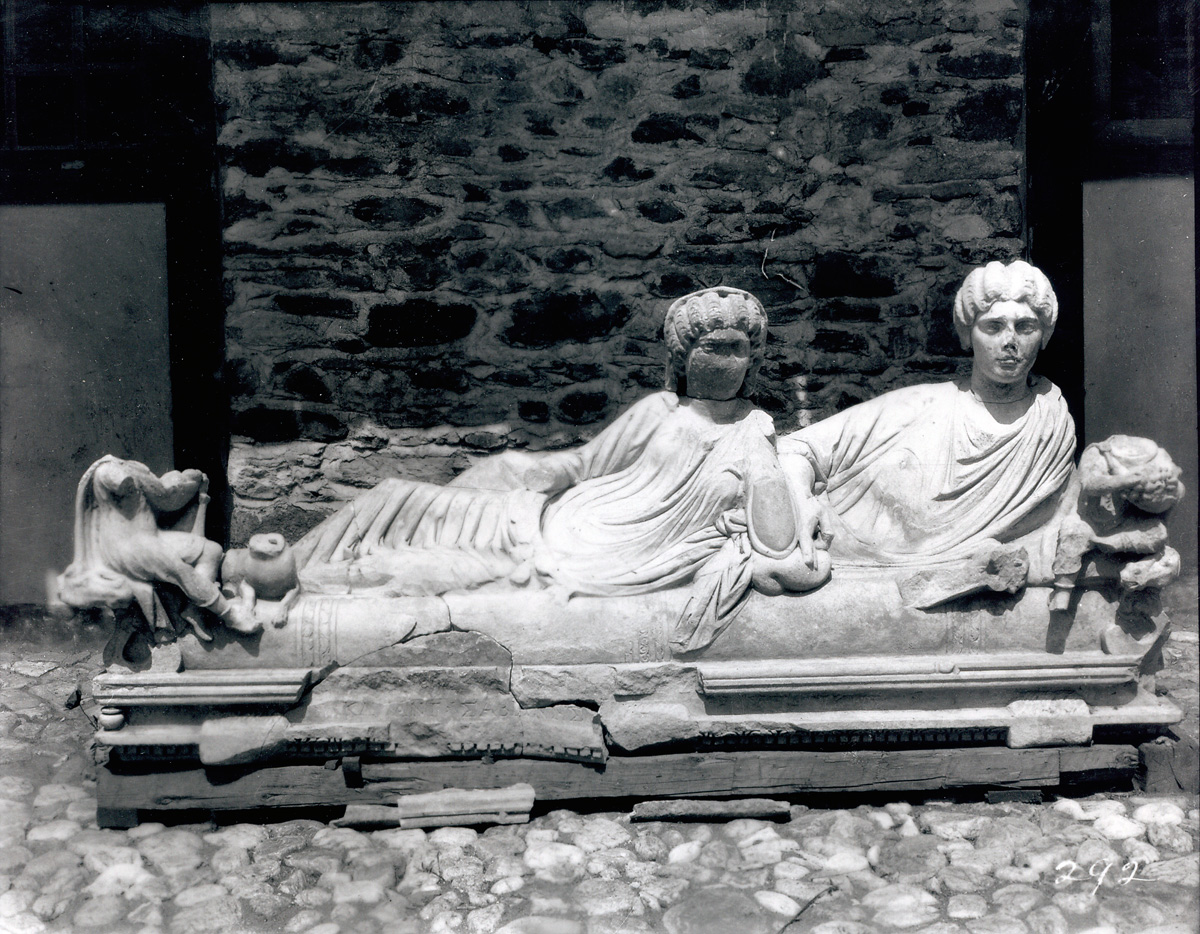 Sarcophagus of Claudia Antonia Sabina
Sarcophagus of Claudia Antonia SabinaR2 Cat. 243
Sculpture, Sarcophagus
Marble, Stone
2nd or early 3rd C. AD (Roman)
For full description and discussion, see Sardis V, 3ff.; Mansel, Erwerbungsbericht, 176, fig. 6; Ferrari, Commercio Sarcofagi, 39; Lawrence, Additional Sarcophagi, 116ff.; Wiegartz, Säulensarkophage, 158 (Istanbul G) and further bibliography therein....
-
 Sarcophagus Fragment
Sarcophagus FragmentR2 Cat. 244
Sculpture, Sarcophagus
Marble, Stone
Ca. 170-180 AD (Roman)
The corner fragment comprises "the cornice of the left intercolumniation of a lateral face, and the left extremity of the adjacent raking cornice" (Sardis V, 39). The interior border is raised to hold the lid. The acroteria consist of a headless anim...
-
 Stele of Menophila
Stele of MenophilaR2 Cat. 245
Sculpture
Marble, Stone
2nd or 1st C. BC (Hellenistic)
The pediment has three acroteria: the central one has two snakes pointing downwards; the other two each have one snake pointing upwards. The recessed niche has tapering sides parallel to the stele sides. The relief shows a woman standing in a Pudicit...
-
 Statue of Moschine, Priestess of Artemis
Statue of Moschine, Priestess of ArtemisR2 Cat. 246
Sculpture
Marble, Stone
50-25 BC (Hellenistic)
The priestess stands twisted slightly to her l., her r. foot drawn back and resting on the toes. She wears a chiton, himation, and platformed sandals, and stands on a square inscribed base.
The himation is drawn from her r. to her l. side across her b...
-
 Winged Eros
Winged ErosR2 Cat. 247
Sculpture
Marble, Stone
Late 3rd C. BC (Hellenistic)
The nude, winged Eros, just older than a baby, stands with the weight on his r. leg, his head turned slightly to proper l. His r. arm is bent at the elbow and across the body. A small fragment of an arrow is held in his r. hand. The l. hand probably ...
-
 Triple Head of Hekate
Triple Head of HekateR2 Cat. 248
Sculpture
Marble, Stone
Roman? (Roman?)
The central head of the Hekateion has circular locks and a floral crown. The two lateral heads have ribbons in their hair which is parted in the center and falls in long locks on their shoulders. They wear turreted crowns. There are incised lines on ...
-
 Double-Sided Herm with Kouros Figure on One Side and Herm on the Other
Double-Sided Herm with Kouros Figure on One Side and Herm on the OtherR2 Cat. 249
Sculpture
Marble, Stone
1st or 2nd C. AD (Roman)
The kouros, treated as a frontal relief, stands with both feet together and both arms down the sides. A strand of hair remains on his r. shoulder. The neck, chest, and abdomen are outlined in a sharp, linear fashion. The pubic hair is somewhat styliz...
-
 Head of Augustus
Head of AugustusR2 Cat. 250
Sculpture
Marble, Stone
1st half of 1st C. AD (Roman)
The idealized head of Augustus is turned slightly to his I. The sharp lines for eyebrows are prominent; the large eyes have no markings for pupil or iris. The nose is sharp and pointed, the mouth small. The face is attractive, but remarkably lacking ...
-
 Head of the Elder Faustina
Head of the Elder FaustinaR2 Cat. 251
Sculpture
Marble, Stone
Ca. 140 AD (Roman)
The following description is after İnan-Rosenbaum: The back of the head is hollow and has a large dowel hole in the center flanked by two oblong dowel holes. Two other dowel holes at ear lobe level are broken away. There are drill channels in the hai...
-
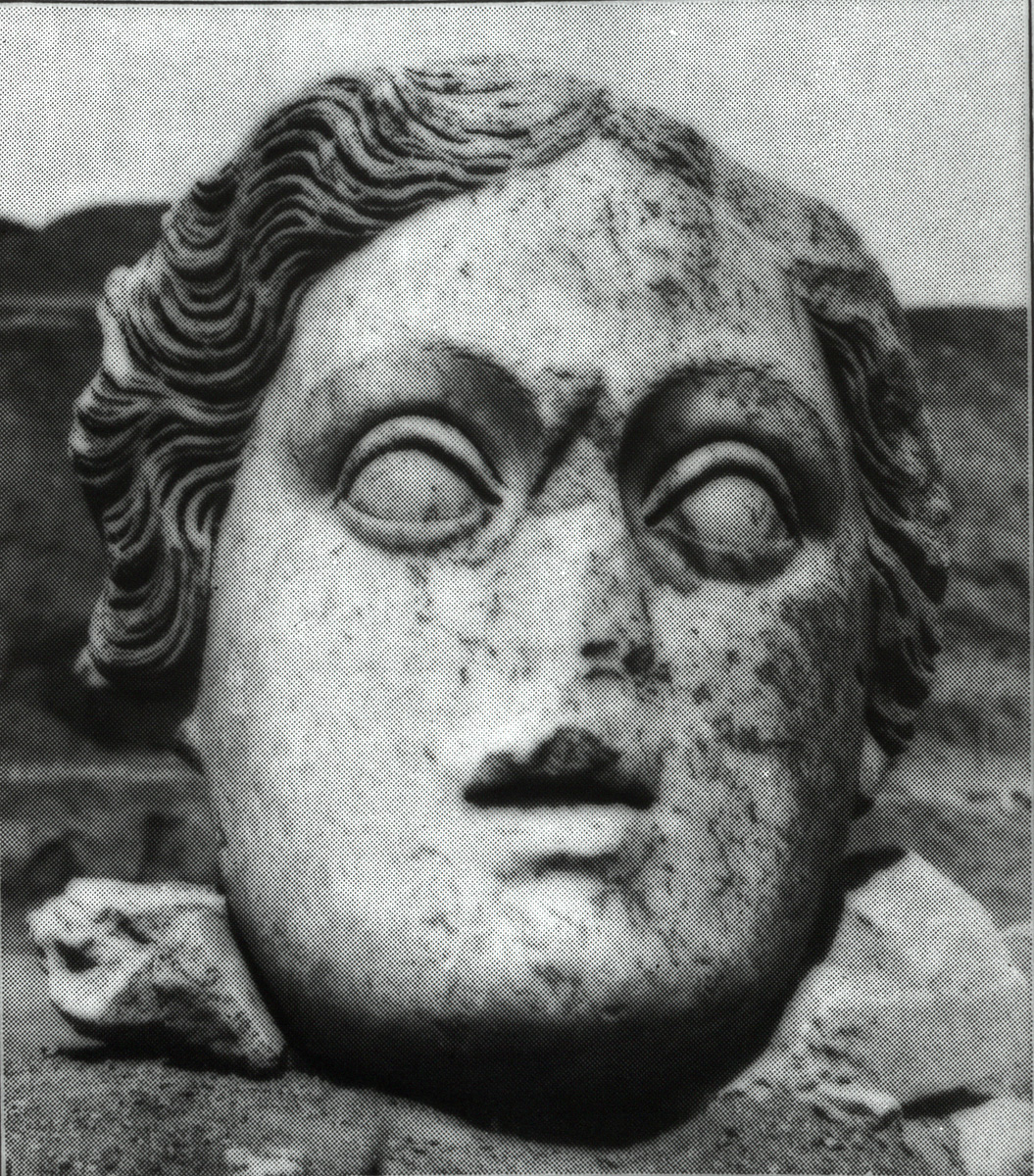 Colossal Female Head, Artemis?
Colossal Female Head, Artemis?R2 Cat. 252
Sculpture
Marble, Stone
Ca. 140 AD? (Antonine) (Roman)
The following description is taken from Sardis I, 147: "A colossal sculptured face, very well preserved . . . differs entirely from the similar heads found here; for, though in high relief, it was almost certainly never part of an entire head, but wa...
-
 Horseman Riding toward Altar
Horseman Riding toward AltarR2 Cat. 253
Sculpture
Marble, Stone
(Hellenistic)
The horseman, according to Buckler and Robinson, has a crescent behind his shoulders and therefore represents Mên (ibid.). He wears a short belted tunic with a few minimal diagonal folds. In his r. hand he may hold a short stick. The beginning of the...
-
 Head of a Woman
Head of a WomanR2 Cat. 254
Sculpture
Marble, Stone
AD 218-235 (Roman)
The portrait was worked for insertion into a statue body. The head is turned slightly to the l., and the woman looks upwards, as indicated by the drilled bean-shaped pupils which are placed high within the incised irises. The surfaces of the eyes are...
-
 Bust of Elpidike
Bust of ElpidikeR2 Cat. 255
Sculpture
Marble, Stone
3rd C. AD (Roman)
The bust of a woman is framed by an arched niche with a pilaster on each side, with simple capital and base. The head is turned slightly to the l. Her hair is parted in the middle and drawn behind her ears, where it falls in heavy locks. The drapery,...
-
 Enthroned Mother of the Gods (Cybele)
Enthroned Mother of the Gods (Cybele)R2 Cat. 256
Sculpture
Marble, Stone
2nd or 3rd C. AD (Roman)
Cybele is enthroned and seated between two lions. The arched recess in which she sits suggests a shrine. She wears a high-girt chiton with a V-neck. The transparent cloth reveals her navel and the shape of her breasts. A heavier cloth himation is dra...
-
 Lion-Headed Table Leg
Lion-Headed Table LegR2 Cat. 257
Sculpture
Marble, Stone
2nd or early 3rd C. AD (Roman)
Roaring lion supports a moulded plinth with inscription:
The inscription may refer to erotes or satyrs who carry off jars and food. The piece may have stood against a wall, supporting a shelf.
-
 Head of a Horse
Head of a HorseR2 Cat. 258
Sculpture
Marble, Stone
(Hellenistic)
The head, which is turned slightly to the r., has a close-cropped mane which swings to the l. at the top. The horse's ears were erect. His lively face has small eyes beneath heavy bones, large and distended nostrils, and an open mouth with teeth show...
-
 Seated Cybele
Seated CybeleR2 Cat. 259
Sculpture
Marble, Stone
Late Hellenistic (Roman)
In plan the statue is a not quite regular rectangle with a projection for the feet. Seen from the back, the lines of the base slant to the l. The goddess sits on the high-backed throne with her legs slightly to proper l. She wears a low polos without...
-
 Lid of Sarcophagus of "Pamphylian" Type
Lid of Sarcophagus of "Pamphylian" TypeR2 Cat. 260
Sculpture, Sarcophagus
Marble, Stone
Late 2nd C. AD (Roman)
There are very carefully trimmed rectangular bosses (H. 0.10; W. 0.14) at the centers of both ends of the sarcophagus and two on each side. The pediment has a plain epistyle, fine dentils, a Lesbian cyma, and plain band. A gutter decorated with doubl...